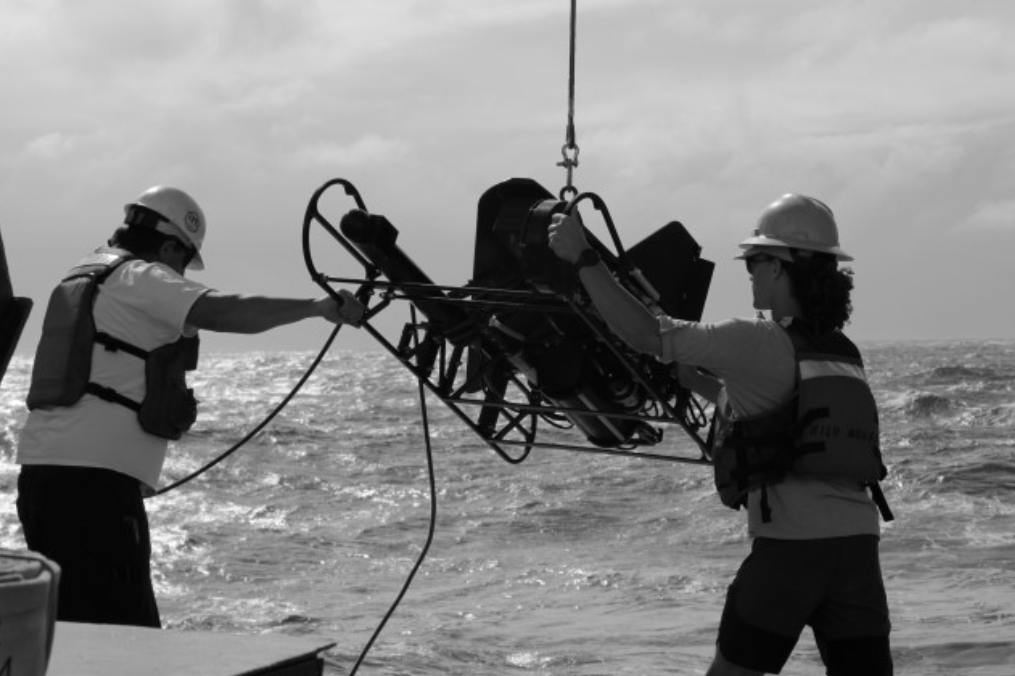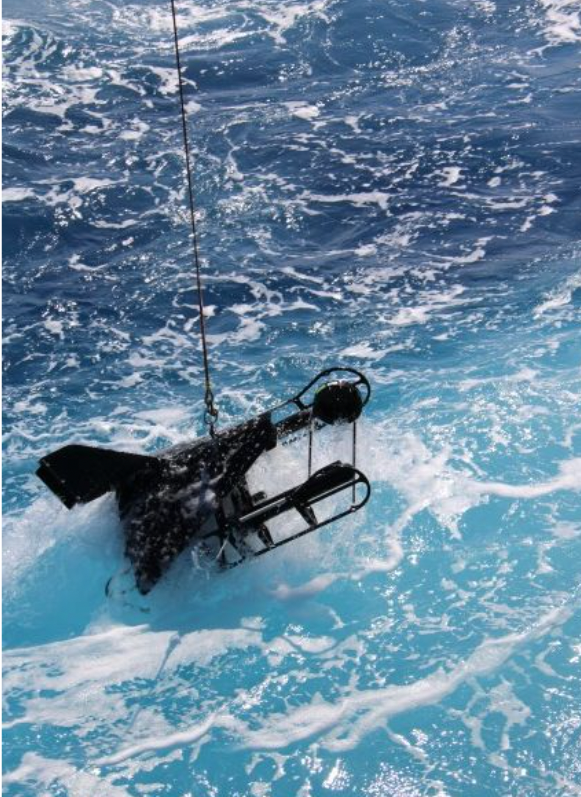$4.5M awarded to UH to advance understanding of ocean carbon, oxygen, heat
 Deploying a video plankton recorder. Credit: Kelsey Maloney.
Deploying a video plankton recorder. Credit: Kelsey Maloney.To address gaps in ocean data and modeling efforts and better understand ocean carbon, oxygen, and heat, four oceanographers at the University of Hawai‘i Mānoa were awarded $4.5 million from the nonprofit Schmidt Sciences. They are team members on two of the five projects selected by Schmidt Sciences and the Schmidt Ocean Institute to join the philanthropy’s Ocean Biogeochemistry Virtual Institute (OBVI).
The five projects and teams will form the inaugural membership of the virtual institute, which has committed $45 million to fund their research over the next five years. The planned research will address the interlinked questions of how rapidly the ocean is gaining heat and carbon while losing oxygen, and the resilience of marine ecosystems in a rapidly warming world.
“This was a competitive search for the best science on the planet and oceanographers at the UH Mānoa School of Ocean and Earth Science and Technology came to play!” said Dave Karl, director of the Center for Microbial Oceanography: Research and Education in SOEST and member of the OBVI Advisory Board.
Subsurface ocean’s impact on sinking carbon
The SUBSEA project, which will bring over $3.8M to SOEST, will examine how marine organisms in the ocean’s twilight zone—a dim layer roughly 200 to 500 feet below the ocean’s surface—alter the absorption and circulation of carbon dioxide in ocean gyres from the North Pacific to the South Atlantic. Subtropical ocean gyres are large, circular currents propelled by wind and the Earth’s rotation. They are among the largest ecosystems on Earth. Algal production in these gyres consumes significant amounts of carbon dioxide, and supports open ocean food webs and fish. As dead fragments of these algae sink, large quantities of carbon are transferred out of the atmosphere and into the deep sea.
“Oceanographers are having a tough time predicting how life in ocean gyres will respond to climate change, but we know nutrients will play a deciding role,” said Nick Hawco, assistant professor of oceanography and UH Mānoa project lead. “Compared to the gyres in the Southern hemisphere, the North Pacific receives a larger supply of nutrients from the atmosphere. This is an amazing opportunity to compare and contrast how the ocean gyres adjust to changes in nutrient supply that we might see in the future,” said Hawco.

Led by Matthew Church at the University of Montana, the project aims to disentangle the effects of two major pathways of nutrient supply, from above and below, in sustaining the carbon balance in the twilight zone. As part of a global team with members based in Argentina, South Africa and across the US, SUBSEA will set sail on research cruises in both the North Pacific and the South Atlantic.
The SUBSEA team, including Angelicque White, UH Mānoa professor of oceanography, and Benedetto Barone, research oceanographer in SOEST, will also work with sea-gliders, wirewalkers, and other ocean robots to track carbon, plankton and nutrients in the twilight zone.
“It is no small feat to sample remote regions of the ocean yet alone regions of the ocean far below the sea surface- we have assembled an arsenal of tools to accomplish our scientific goals,” said White. “We’ll set instrumented arrays afloat at sea; we will deploy gliders that profile from the dark ocean depths to the sunlit surface and we will trace the contours of ocean biology and chemistry with state-of-the art tools from aboard research vessels, including the relatively new R/V Falkor (too).”
Integrating computer models and observations
The global ocean helps mitigate climate change by absorbing heat and carbon, but is also experiencing a triple threat from warming, decreasing oxygen, and increasing acidification that may cause harm to marine ecosystems. The second newly-funded project, InMOS, will bring over $700,000 to UH Mānoa and use artificial intelligence and machine learning to develop estimates of sources and sinks of ocean heat, carbon, and oxygen for the past 35 years. Project members aim to both reduce uncertainties in these budgets and achieve an unprecedented level of understanding of the physical and biogeochemical processes affecting these interlinked cycles.
“I’m excited to work with our diverse project team,” said Seth Bushinsky, UH Mānoa assistant professor of oceanography and InMOS project team member. “Often we approach the questions of ocean carbon uptake or oxygen loss from an individual set of measurements. In InMOS, we will approach these critical questions simultaneously using ocean and atmospheric observations alongside state-of-the-art modeling approaches. This framework will let us understand both the magnitude of air-sea exchanges, but also test our mechanistic understanding that is crucial for projections of future changes in the global climate system.”

The InMOS collaboration is led by Tim DeVries at University of California, Santa Barbara and Ralph Keeling at Scripps Institution of Oceanography and will bring together ocean and atmosphere observational and modeling communities.
Bushinsky will lead the effort to develop new marine observational products based on large data sets of ocean carbon, oxygen, and nutrient measurements.



